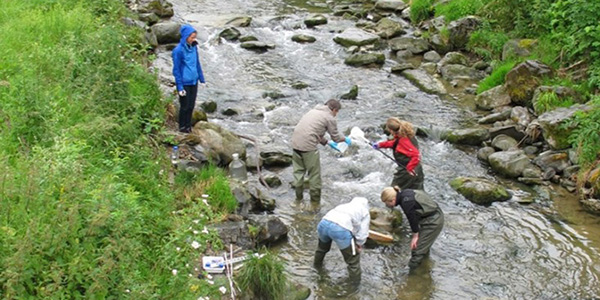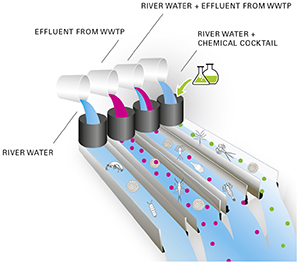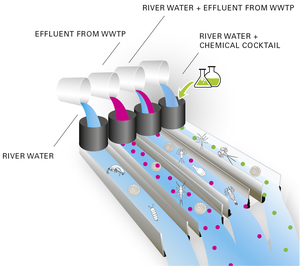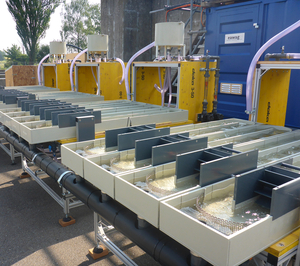EcoImpact 1
EcoImpact – unraveling the ecological impact of micropollutants in streams

The contamination of freshwater systems with micropollutants (MPs) is regarded as a key environmental problem, and a wealth of data on the impact of MPs on specific organisms exist, but we know little how these MPs impact the complex structure and function of entire natural aquatic ecosystems.
EcoImpact 1 was an Eawag-wide interdisciplinary research effort aimed at filling this knowledge gap. The project started in 2013 and was strongly motivated by the upgrading of the Swiss wastewater treatment plant infrastructure. These modifications represent a unique opportunity to study the impact of MPs on natural aquatic ecosystems. To that end two complementary approaches were pursued: A field survey at selected wastewater treatment effluent sites and experimental approaches including a flume system (Maiandros) with controlled water chemistry. Maiandros was developed to experimentally investigate the effects of mixtures of MPs on biological endpoints.
Project partner
Federal Office for the Environment (FOEN), Dept. Water
- Aquabug, Sciences naturelles et environnement, Neuchatel
The partners are governmental and cantonal authorities as well as companies and the non-profit organizations.
Water Lecture (Video) at the University of Waterloo
12 January 2017
Speaker: Christian Stamm, Eawag
Unraveling the impacts of wastewater-borne micropollutants in stream ecosystems
Micropollutants
Micropollutants (MPs) are organic or inorganic chemical pollutants which occur in water bodies in very low concentrations. Despite such low concentration levels, MPs can have negative impacts on organisms or contaminate the drinking water resources. MPs are derived from many products used in industry, agriculture, tourism and households and include personal care products, construction material, pharmaceuticals or biocides. They enter the water environment via various routes such as urban wastewater, or runoff from agricultural land or transportation areas.
Effects of micropollutants
Many MPscompounds are developed to be biologically active (e.g. biocides, pharmaceuticals, plant protection products). Therefore it is to be expected that similar but undesired side-effects can be observed in the environment. Herbicides for example that inhibit photosynthesis in weeds also stop photosynthetic activity in algae and macrophytes. Vertebrates, such as fish, will also react on e.g. hormones, or insecticides will also have a negative impact on insects in an aquatic environment.
Incomplete removal of MPs in conventional wastewater treatment plants
A major source for MPs in the aquatic environment are wastewater treatment plant (WWTPs) effluents. Conventional WWTPs have mainly been developed to remove nutrients. They successfully contributed to achieve water protection goals. Many MPs though are not sufficiently removed by conventional treatment processes. Therefore the Swiss authorities have decided to implement additional treatment steps on about 100 out of the 700 Swiss WWTPs. These modifications represent a unique opportunity to study the impact of MPs on natural aquatic ecosystems in our project EcoImpact.
Hypothesis and Goals
In a combination of surveys and experimental approaches, EcoImpact 1 tested the following two hypotheses:
- The discharge of MPs from WWTPs leads to changes that go beyond the effects of other wastewater constituents like nutrients (e.g., the loss and reduction of sensitive species at downstream sites or induced tolerance against MPs).
- There are indirect effects of MPs, mediated by biological interactions that go beyond the direct effects of MPs on key organisms and functions.
The EcoImpact 1 project had three goals
- Establishing causation
We wanted to establish whether ecological differences between sites are caused by different exposure to (specific) groups of MPs. The impact of MPs and confounding factors had to be separated. - Integration
We included a variety of molecular, physiological and ecological endpoints, and integrate the measurements, observations and patterns. - Establishing generality
We aimed at general statements rather than specific statements on individual study sites.
Survey and field sites
In the survey, established methods were used to assess the water quality parameters, various biological endpoints, biodiversity and functional traits at a selection of 24 river reaches up- and downstream from wastewater treatment plant discharges across the Swiss Plateau and the Jura mountains. The goals of this approach was to examine biological effects of treated wastewater in general and MPs in particular, and to establish a baseline for monitoring subsequent changes caused by upgraded WWTPs.
Site selection was based on the following criteria and was aimed at obtaining scientifically significant results, which will allow to draw generalizable conclusions:
- Only streams are considered as receiving waters, no lakes
- No wastewater discharge upstream of the selected WWTPs
- At least 20% of total discharge consists of WWTP effluent during dry weather flow (Q347)
- Settlement area in catchment < 21%
- Less than 10% areal coverage with vineyards and/or orchards
Experimental approaches
Experiments are needed to disentangle the effects of different factors on the structure and function of aquatic ecosystems. To study the specific role of MPs we performed laboratory-based, small scale experiments but also designed a 16 channel flume system called Maiandros (from the Greek Μαίανδρος being the God of the River Maeander in modern Turkey).
In the Maiandros system different organisms can be exposed to four different and controlled water qualities. Maiandros was located at the WWTP in Fällanden, Switzerland, and several experiments have been executed so far. Water quality was on the one hand varied by mixing river water and effluent from the WWTP in different ratios. On the other hand, river water was dosed with nutrients and/or artificial mixtures of MPs.
Results
Findings demonstrated that MPs exert different impacts on stream ecosystems. At all field sites, wastewater discharge substantially increased the load and concentrations of MPs at the downstream locations. Bioassays clearly show that these concentrations increase the ecotoxicological effects at different endpoints like inhibition of photosynthesis. Periphyton communities downstream are more tolerant to these MPs, and induced gene expression of detoxification activities in brown trout has been demonstrated at selected sites. All of these results demonstrate that MPs exert stress on the organisms resulting in biological responses. Such effects are also seen with macroinvertebrates. In particular, species that are sensitive against pesticides are reduced at downstream sites, indicating the presence of these toxicants in the treated effluent. This effect gets larger the more wastewater is discharged in relation to the average stream flow. Interestingly, this effect was independent of how pristine the stream was upstream of the WWTP. Ecosystem functions like leaf decomposition were also affected by wastewater discharge and potentially by MPs.
Using the Maiandros flume system, four experiments have been conducted that allowed to disentangle some of the intricate processes occurring in the field. For example, degradation assays using cotton strips showed that nutrients ‘mask’ the toxic effects of MPs on this functional endpoint.
Publications
The following selection of publications are from or strongly related with the EcoImpact topic.
Project team
Project Management
Project leader: Christan Stamm
Project team
The project is carried out in close collaboration with members of the wider project team, which consists of representatives of different Eawag disciplines and the Ecotox Centre of the Eawag/EPFL.

Dr. Francis J. Burdon
former Eawag PostDoc
in EcoImpact 1
The different project tasks will be carried out by task groups which consist of scientific and technical personnel of all levels and will be supervised by a task leader.
Research partners
Assoc. Prof. Scott D. Tiegs, Biological Sciences, Oakland University, Michigan, USA
Dr. Yaohui Bai, Research Center for Eco-Environmental Sciences, Chinese Academy of Sciences, Beijing, China
Scientific Advisory Board
Prof. Dr. R. Brouwer
Professor in Environmental Economy, University of Waterloo, Canada
Prof. Dr.-Ing. Martin Jekel
Professor in Environmental Engineering, Technical University, Berlin, Germany
Dr Pim E.G. Leonards
Senior researcher department of Chemistry and Biology, Vrije Universiteit, Amsterdam, The Netherlands
Dr. Guy Woodward
Reader in ecology, Imperial College, London, England

















